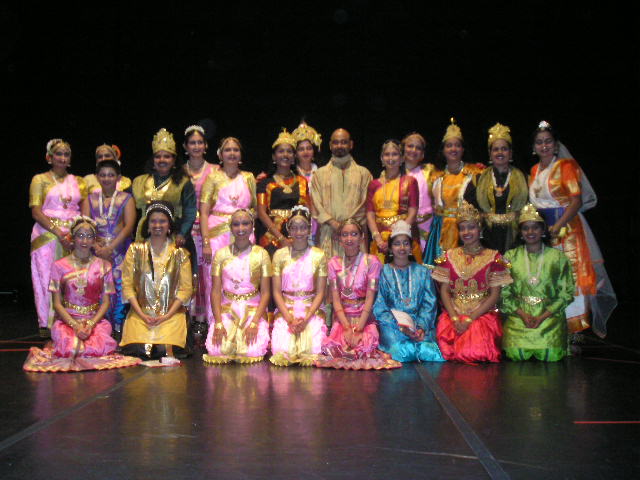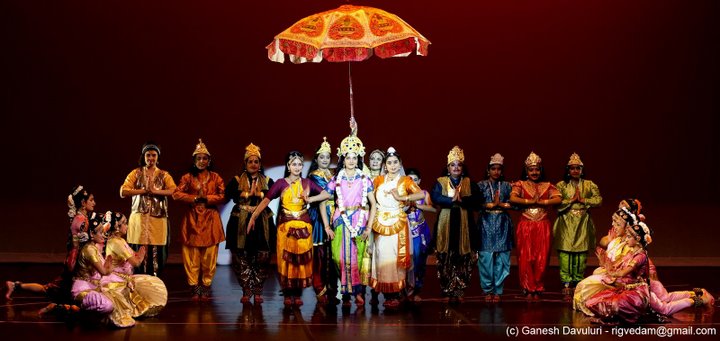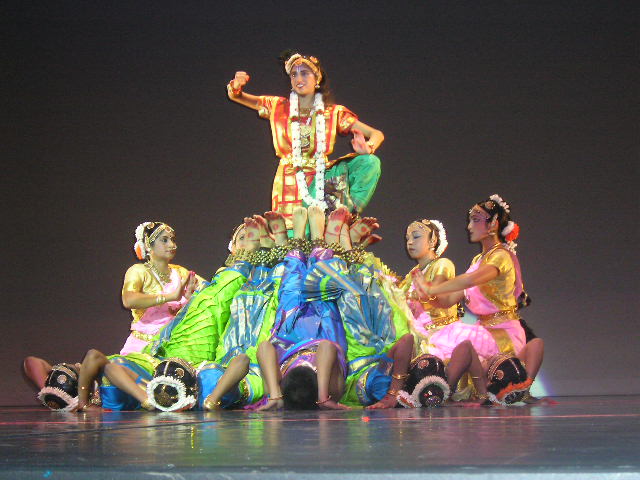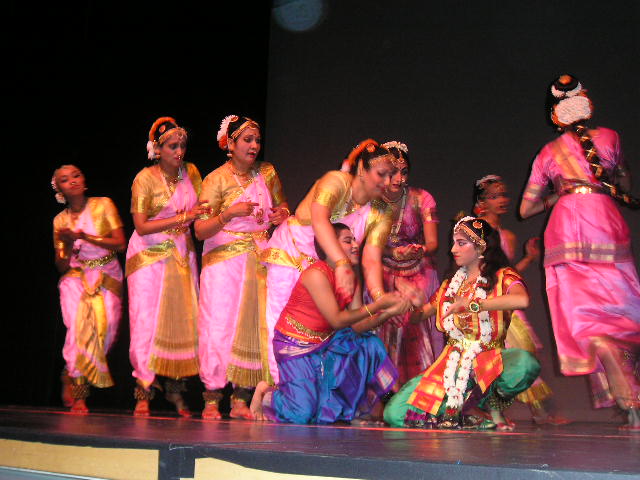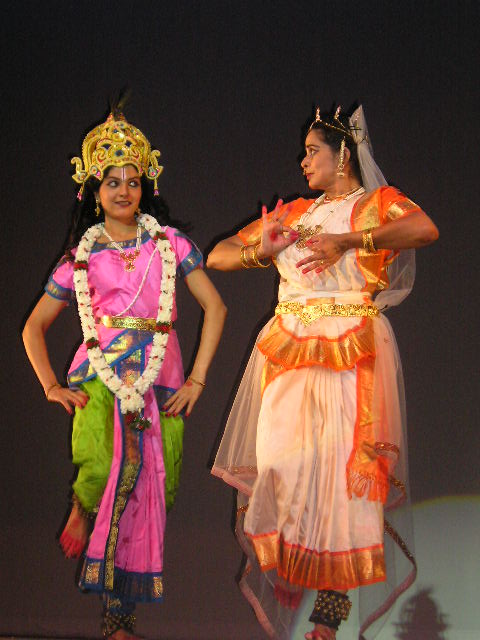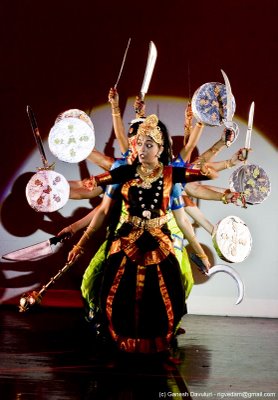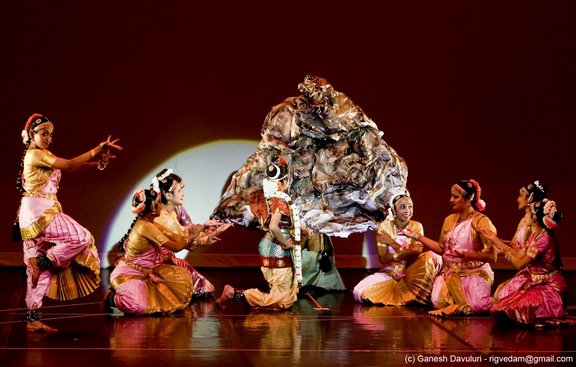Contribute
| Lord Krishna Reincarnates In Boston |
Ganesh Davuluri
07/23/2009
The thriving scene of Bharathanatyam in New England was elevated to new heights this last Saturday. 'Krishna - A Ballet' by Shri. Madurai. R. Muralidharan, a well accomplished dancer-cum-choreographer-cum-musicologist-cum-composer-poet-cum..., overwhelmed the seasoned Bharathanatyam audience of New England by radically redefining the standards of creativity, grandiosity and technicality for Bharathanatyam Ballet productions, at least here in the New England area, if not all over the US.
After initially grouping in the dressing room for a collective recitation of 'Sahanavavatu.. ' and Guru vandana, the cheerful group of dancers started the ballet with a picturesque visualization of the episode, from Srimad Bhagavatham, of an elated Kamsa celebrating the wedding of Devaki (Amuda Pazhanisamy) and Vasudeva (Kruti Ravaliya) in his palace, only to be warned by the Akashvani (the invisible voice), while on a pleasure ride in his chariot with Devaki and Vasudeva, about his imminent death at the hands of the eighth child of Devaki. Vyjayanthi Prasad skilfully enacted the transition of Kamsa from being an indulging, loving brother to a heinous villain. Amuda gracefully portrayed Devaki's initial affection towards brother Kamsa that transforms into a fear and agony of losing child after child at Kamsa's hands, while Kruti is adequate at the portrayal of Vasudeva.
The vivid scene depicting Vasudeva crossing the flooding Yamuna on a stormy night to exchange the newborn eighth child of Devaki with the cowherds Nanda and Yashoda's new born baby girl reveals a glimpse of the intriguing choreography by Muralidharan.
The creativity of the choreographer continues to impress with the visual interpretation of Goddess Kali (Sujatha Meyyappan) that captures the splendor and magnificence of the Goddess shining in all Her glory with seething anger towards evil Kamsa. Sujatha Meyyappan's electrifying movement, keen sense of tala and intense abhinaya ably showcase the ferociousness of an angered Kali.
The Gokulam scene of baby Krishna in the jhoola is tastefully conceived and decorated, and the playful portrayal, by various dancers, of the inquisitive friends and family of a gushing Yashoda (Poornima Risbud) and dutiful Nanda (Ira Padye) effectively conveys the festive spirit of Krishna's Namakaranam episode, one that modern day parents can most directly relate to. Mangai Gopalan captures the vile and cloaked cunning of Puthana lucidly.
Baby Krishna's mischievous pranks shine persuasively through the unsullied innocence of child dancer Aniruddha Nagesha. Poornima Risbud poignantly embodies Yashoda's mixed emotions of intense affection, motherly restraint and momentaty displeasure towards Krishna in face of neighborly complaints, especially from the pesterly gopi (Pallavi Nagesha), to the T.
The elaborate enactment by Aniruddha of child Krishna trying to be released from being tied to a mortar by passing around the twin arjuna tree was cute. The tree props made by Poornima and Shachi Risbud add realism to the Ulookhal Bandhan scene where the child Krishna tied to a mortar passes through the twin trees and uproots them, thus releasing Nalakuvara and Manigriva, the demigod sons of Kubera, from Narada's curse.
The intricate Kalinga Nartana tillana with plentiful bols benefits from the vibrant energy and agility springing from the fountain of youth of Shachi Risbud's young Krishna. It is in the quick and visually interesting formation of a subdued Kalinga mounted by the victorious young Krishna that Muralidharan achieves the pinnacles of intelligent choreography and creative theatrics with just the dancers and limited props.
Indhra Rajasekhar was convincing as the celestial Indra who dumps torrential rain on the Vrajbhumi, furious that the people of Vraj stopped worshipping him and instead started worshipping the Govardhana Giri. The Giri prop made by Muralidharan himself enhances the visual appeal of the scene.
Ananya Mahalingam as the yukta Krishna and Sharayu Mahale as Balarama satisfy with invigorating nritya, while synchronised movements by the dancers enacting other Yodhas add vibrance and depth to the Chanura Mardanam and the Kamsa Vadha episodes.
Hema Iyengar as a vivacious and strikingly gorgeous Adult Krishna and Jeyanthi Ghatraju as a charming and graceful Radha articulate an intimate chemistry with an uncanny precision on laya, and a meticulous attention to symmetry in movement, making the divine romance of the Rasa Leela come alive. Muralidharan's creative usage of a spotlight to project an alluring full moon in the backdrop accentuates the idyllic mood.
Soon, Shakuni (Poornima Surya) taking to the stage with his characteristic sheepish smile and limping gait sets the stage for the Great War, in scheming with Duryodhana (Indhra Rajasekhar) and Dusshasana (Ranjani Saigal).
Ranjani Saigal's internalization of Dusshasana with seasoned histrionics, Indhra Rajasekhar's dramatic abhinaya as the cruel Duryodhana and Poornima Surya's adept characterization of the wicked Shakuni expose the treachery of the villainous characters to the core during the Draupadi Vastrapaharanam episode, building up an 'edge of the seat' drama.
Sangita Raghunathan explores the interplay of shame and anger in the mosaic of Draupadi's psyche with grace and excellent footwork
in the Panchali Shapatham episode. Rangapriya Rajasekhar as the sorrowful Dharmaraja defeated at the game of dice and Harini Rajasekhar as the wise but helpless Nakula are adequate.
After being treated to hyper dramatization and clever theatrics during the initial sequences, the spoilt audience eagerly hoping for an extremely dramatic visual interpretation of the Vishwa Rupa Sandarshanam of Lord Krishna during the Geetopadesham to a shaky and conflicted Arjuna (Abirami Manian), had to contend with a relatively sober interpretation of the Lord's Universal Manifestation.
The synchronous footwork and energetic nritya of various dancers employing weapons and shields made by Poornima and Shachi Risbud create an impactful war scene culminating in the victory of the Pandavas and a grand celebratory ending.
The splendor of the set and props donated by Shobha Sastry of Alankar decor deserves plaudits for lending immense period grandeur and authentic ethnic mood to the beauty and lyricism of the ballet presentation of the epics. The aharya (costumes) is grand, detailed, elegant and classical.
The expertise of the seasoned dancers at the nuances of achieving spatial dimensionality in adavus, of maintaining the chiseled beauty of araimandi and prenkhana, of executing lucid sancharis and graceful theermanams, and of mixing in perfect measures of the 3Ns, Abhinaya, paired up expertly by Muralidharan with the right amounts of dramatisation, theatrics and energetic music and creative lighting effects enable this event's recipe to cleverly and wholesomely harness the intrinsic epic scope offered by the subject matter from Srimad Bhagavatham and Mahabharatham.
With more than 20 renowned Bharatanatyam teachers and their senior students from various New England states being involved in this scintillating production, it wouldn't be an exaggeration to say that the ballet performance showcased the finest distillation of abundant Bharatanatyam talent that the New England area witnessed on such a grand scale ever. “Our idea was to bring the dancing community together and present a show of unity, where dedication and commitment were the only factors consideredâ€, said Jeyanthi Ghatraju who played a key role in coordinating the event. No wonder they got a standing ovation for a long, long time from the bedazzled audience.
If you are connoisseur of dance and missed this grand performance, despair not, for the master choreographer has already announced his next production - Silappadhikaram - to be hosted at the same venue next year.
If there's one thing that can be done to improve the production, it would be to consider using Samskritam, Hindi, Kannada, Malayalam, Telugu, verses if and where possible and appropriate, at least for some parts of the upcoming productions. Although the English narration helps set the context for those in the audience who are unfamiliar with Tamil, and the familiarity of the epic storyline itself helps, multi-lingual verses may help enhance the fan-base and the scope of appreciation of the audience.
The proceeds from the event benefit Vision-Aid (http://www.visionaid.org). The Vision Aid team of Anu Chitrapu, Shailesh Durgapal, Paramesh Garimella, Supriya Lagu, Ramakrishna Raju, Revathy Ramakrishna, Umayal Ramanathan, Sudhir Varma, Santosh Vempala and Anupam Wali managed the event logistics with seasoned efficiency, despite running into a standing-room only situation with people pouring in well into the first half hour after the start of the event co-publicized by MITHAS (http://www.mithas.org)
This is the second successful show (after the highly acclaimed Ramayana presented last year) and both times the events have been organized beautifully. Sudheshna Das's designs helped make classy publications. T
"We are grateful to the artists for presenting the event completely free of charge, bearing the cost of music, training and costumes. Thanks to their genorisity we were able to raise valuable funds to serve the needy in India" said Ramakrishna Raju. To learn more about Vision-AID please check out their website at http://visionaid.org
You may also access this article through our web-site http://www.lokvani.com/
